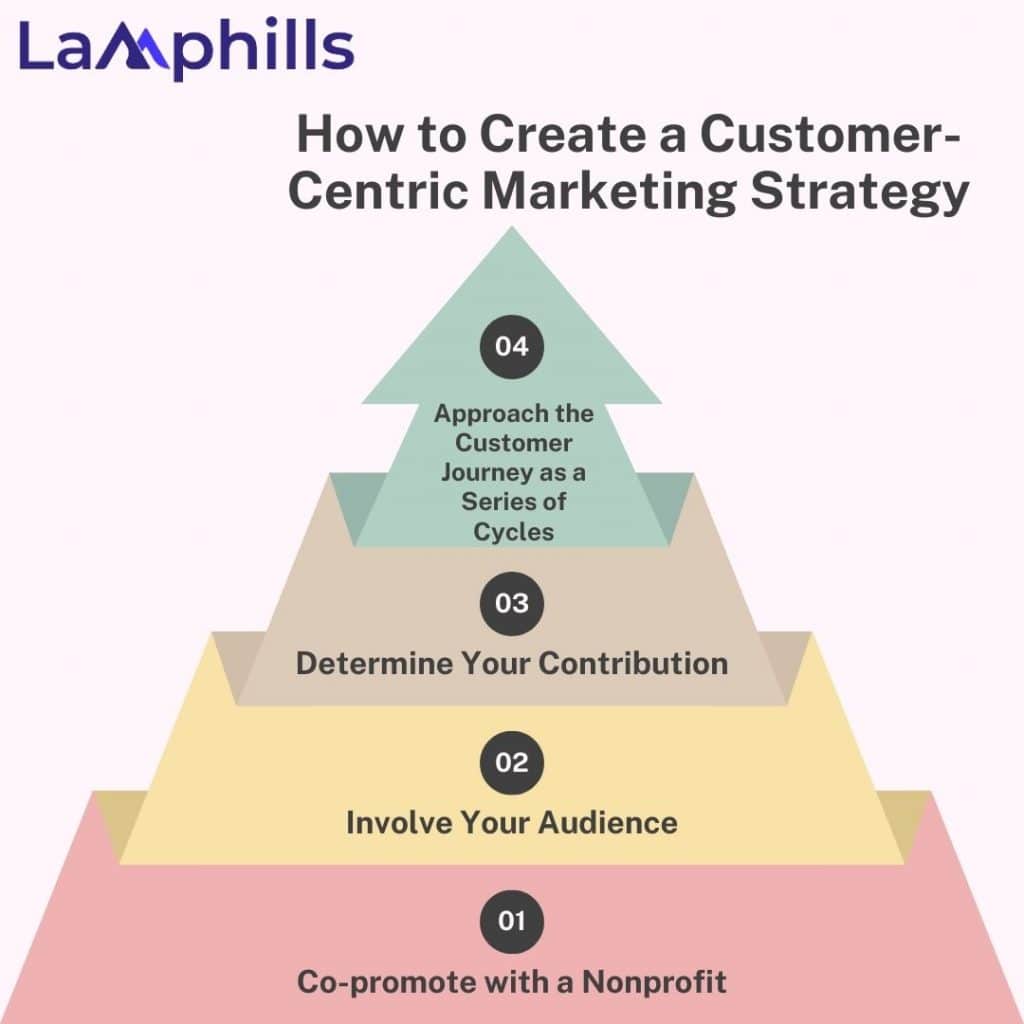Imagine walking into a store where every product, interaction, and communication seems tailored just for you. This is the magic of customer-centric marketing. But what exactly does it entail, and how can businesses harness its power to drive success? That’s what we’re about to explore. In this guide, we’ll dive into customer-centric marketing strategies and customer-centric marketing examples that demonstrate how focusing on the customer can transform a business. I will also share my story highlighting this approach’s impact.
Key Points
- Successful customer-centric marketing starts with a thorough understanding of your audience. This includes conducting market research, utilizing surveys, analyzing social media, tracking customer interactions, and leveraging intent data to tailor marketing efforts and anticipate customer behavior.
- Leaders should embody customer-centric values, encourage open communication, promote cross-functional collaboration, prioritize training and development, and recognize customer-centric behavior.
- Customer-centric marketing examples include Bacardi, INFINITI, VAPE, and The Honest Company. These examples showcase creative approaches to engage and delight customers, such as personalized content, seamless online-to-offline experiences, full-funnel campaigns, and interactive livestreams.
- Customer-centric marketing builds trust and sustains positive customer relationships. It enhances the customer experience across all touchpoints, ensuring resilience against shifts in shopping behaviors and industry disruptions.
Understanding Customer-Centric Marketing

Credit: Freepik
A few years ago, I had a friend working at a company that struggled to connect with its audience. Sales were stagnant, and customer feedback was less than favourable. The company decided to pivot to a customer-centric approach. They started by listening to their customers. They analyzed feedback, observed customer behaviour, and engaged with them directly. One strategy they implemented was creating personalized content that addressed specific customer needs and preferences. The results were astounding. Customer satisfaction skyrocketed, and they saw a significant increase in sales and loyalty.
Customer-centric marketing means giving customers what they need and want at every interaction. Imagine the customer journey as a constellation of stars, each star being a chance to connect and inspire loyalty. Start by looking at the overall experience your company provides. Where are customers interacting with your brand? What content and experiences are you offering at those points? How can you make each touchpoint better and link them together? Use this information to keep improving the customer experience.
Benefits of Customer-Centric Marketing
Customer-centric marketing brings multiple benefits. Customers appreciate positive interactions with brands, which in turn help build and sustain trust. According to a Salesforce survey, 73% of customers indicate that one outstanding experience raises their expectations from other companies.
Moreover, adopting a customer-centric approach in marketing and advertising is a crucial long-term business strategy. Continuously enhancing the customer experience across all advertising touchpoints ensures resilience against shifts in shopping behaviours, changes in preferred channels, or disruptions within the industry.
Read: Content Marketing for Startups: Growth Hacking Secrets for Explosive Traffic
Customer-Centric Marketing Examples

Credit: Freepik
For inspiration on what customer-centric marketing and advertising can look like, let’s look at how four brands used creative approaches to engage and delight customers across various channels.
#1. Bacardi
Bacardi turned customers’ living rooms into tasting rooms. While Bacardi is best known for its rum, it has an award-winning collection of single-malt whiskies. Bacardi created a live-tasting experience that customers could enjoy from home to raise awareness among whisky enthusiasts in the U.K. and Germany.
They introduced the Single Malt Discovery Collection, featuring three exclusive whiskies. Customers in the U.K. and Germany could buy this collection on Amazon and gain access to a live-streamed tasting event held in October 2019. Customers could ask the expert hosts questions via a custom Amazon landing page during the event. Over 500 questions were asked, and Bacardi saw a significant boost in whisky sales on Amazon.
#2. INFINITI
INFINITI, known for luxury and innovation, offered a seamless online-to-offline test drive experience. It aimed to surprise customers by giving them a firsthand experience of its vehicles. 2019 INFINITI Canada created a seamless online-to-offline experience for test drives in an unexpected location.
They set up a test-drive pop-up inside Yorkdale Mall, Canada’s most prominent luxury mall. This setup featured a home façade with curated items available through Amazon SmileCodes. Customers could see and experience the INFINITI QX50 and were encouraged to visit local dealers. The campaign was boosted with influencer marketing, prominent placements on Amazon.ca, and a custom landing page. Using the Amazon D.S.P., they delivered brand messages across devices and formats to reach exclusive Amazon audiences. The 10-day event generated over 2,000 interactions with product specialists, resulting in more than 300 event test drives and 600 dealership test drives.
#3. VAPE
VAPE created a brand buzz with a customer-centric approach. The insect repellent company wanted to build awareness in Italy through a unique campaign highlighting mosquitoes’ annoyance.
They partnered with Amazon Ads to create a full-funnel campaign targeting every customer journey phase. Using Amazon’s audience insights, they reached people interested in similar products, including sports lovers, ecologists, parents, and outdoor enthusiasts. VAPE created ad content based on shopping insights, such as showing a banner with a broom swatting away mosquitoes before introducing their product. This creative approach led VAPE to become the top seller of insecticide on Amazon. in the summer of 2020.
#4. The Honest Company
The Honest Company provided valuable content at every interaction. Jessica Alba founded The Honest Company in 2012, driven by her desire for trustworthy everyday products. The brand now offers a wide range of baby, cleaning, beauty, and bath products.
The Honest Company developed a comprehensive strategy to connect with their busy audience of new parents. They used over-the-top (O.T.T.) videos to build brand awareness and Amazon D.S.P. to reach exclusive Amazon audiences on various sites and apps. A live stream on Amazon Live with Jessica Alba allowed customers to interact with her and shop for products in real time. Additionally, they used Sponsored Products to reach high-intent shoppers and offered coupons on product detail pages. This approach led to a fivefold increase in detail page views from O.T.T. impressions, a 39% higher return on ad spend, and continuous quarter-over-quarter growth in reach.
Customer-Centric Marketing Strategies
Customer-centric marketing strategies focus on putting the customer at the heart of all marketing efforts. These strategies prioritize understanding and addressing the needs, preferences, and behaviours of customers to create personalized and meaningful experiences
Customer Marketing: 8 Killer Customer Marketing Strategies for Building Your Brand
Here is a comprehensive social media engagement checklist that ensures you effectively interact with your audience, build relationships, and enhance your brand presence:
How to Create a Customer-Centric Marketing Strategy
If you want to create a customer-centric marketing strategy like the brands we’ve discussed, here are the key steps to consider:

- Approach the customer journey as a series of cycles.
- Understand your audience.
- Offer value to every customer interaction.
- Measure and optimize.
#1. Approach the Customer Journey as a Series of Cycles
The customer journey is a full-funnel approach that allows customers to be at any stage. Look for opportunities to engage them at each touchpoint, whether creating brand awareness or providing detailed product information. Ensure that every interaction can inspire discovery, consideration, purchase, and loyalty.
#2. Better Understand Your Audience
Develop a multi-dimensional understanding of your audience. Know who your customers are beyond just demographics and understand how they engage with your product. For instance, Bacardi didn’t just target specific age groups in set locations; they aimed to engage new and experienced whisky drinkers who appreciate craft and luxury, creating an experience tailored to them.
If you’re a hand cream company with sustainable packaging, part of Amazon’s Climate Pledge Friendly program, highlight this to environmentally conscious shoppers. Focus on messaging about sustainable packaging and Climate Pledge Friendly certification rather than just the hand cream scents.
#3. Offer Value at Every Interaction
Each brand we’ve examined aimed to provide meaningful engagement at every touchpoint. The Honest Company offered discounts and interactive livestreams with Jessica Alba. INFINITI created immersive online and offline experiences. VAPE made shopping for household staples like insect repellent fun and engaging.
#4. Measure and Optimize
Measure and analyze your efforts to see what works and what doesn’t. Use data to make informed decisions and refine your strategy. For example, as VAPE did, customized creative resonates more with your audience. An athletic wear company might discover that local images resonate better with customers in specific cities. Test and iterate your messaging, like seeing if sustainability messaging appeals to a broader audience beyond environmentally conscious shoppers.
For more inspiration, dive deeper into how to use measurement to develop a customer-centric advertising strategy.
Steps to a Customer-Centric Marketing Approach
A successful customer-centric marketing approach hinges on three essential steps. Follow this strategic guide to put your customers at the heart of your marketing efforts.
#1. Understand Your Customers
A deep understanding of your audience is the foundation of a customer-centric strategy. This ensures that your campaigns resonate and remain relevant.
Here’s how to gain that understanding:
- Conduct Market Research: Use qualitative methods (like interviews and focus groups) and quantitative techniques (such as surveys and questionnaires) to uncover customer expectations, preferences, and needs.
- Utilize Surveys: Gather direct feedback through emails, online polls, or website forms.
- Analyze Social Media: Monitor engagement metrics, such as comments, shares, likes, and mentions, to gauge customer preferences and sentiments.
- Track Customer Interaction: Observe how customers engage with your brand across various platforms and channels, including your website, emails, and reviews.
- Leverage Intent Data: Use signs of purchase intent, such as keyword searches and website visits, to anticipate customer behaviour and tailor your marketing efforts accordingly.
Read:15 Best Inbound Marketing Tools That Can Save Your Business in 2024
#2. Add Value to Every Interaction
This step is about differentiating your brand and making a lasting impression on your customers.
Here’s how to add value:
- Deliver Relevant Content: Provide content tailored to your customers’ interests and needs. This could be insightful blog posts, helpful how-to guides, or informative product demos.
- Personalized Communication: Use customized emails, social media responses, and other communications to show customers they are valued individuals.
- Offer Exclusive Rewards: Show appreciation for customer loyalty with special deals, discounts, or rewards.
- Educate Your Audience: Share your industry expertise through webinars, eBooks, or informative emails to help customers make informed decisions.
- Listen and Respond to Feedback: Create a two-way conversation with your customers via social media, feedback forms, or review sites. Respond constructively to criticisms and show gratitude for positive feedback.
#3. Engage Leadership
Leadership involvement is crucial for embedding a customer-centric approach throughout your business.
Here’s how leaders can drive this approach:
- Embody Customer-Centric Values: Leaders should prioritize customer obsession in their decisions and actions, setting a powerful example.
- Encourage Open Communication: Foster a culture of welcoming customer and staff feedback.
- Promote Cross-Functional Collaboration: Break down silos between departments to ensure a cohesive customer journey.
- Prioritize Training and Development: Invest in training programs that empower your team to deliver exceptional customer experiences.
- Recognize Customer-Centric Behavior: Reward team members who go above and beyond for customers to inspire others.
Tips for Enhancing Customer-Centric Marketing
- Build a Customer Journey Map: Visualize your customers’ interactions with your brand to identify gaps and improve experiences.
- Improve Website Usability: Ensure your website is user-friendly with intuitive navigation and fast loading times.
- Create Engaging Content: Develop interactive and relevant content like infographics, videos, and webinars.
- Provide Excellent Customer Support: Use every interaction to exceed expectations with quick, empathetic, and proactive assistance.
Related articles
What Marketing Capabilities and Why it is Important for Your Brand Success
Understanding Lifestyle Marketing: Strategies and Benefits for Brands
MARKETING VS ADVERTISING: Differences






